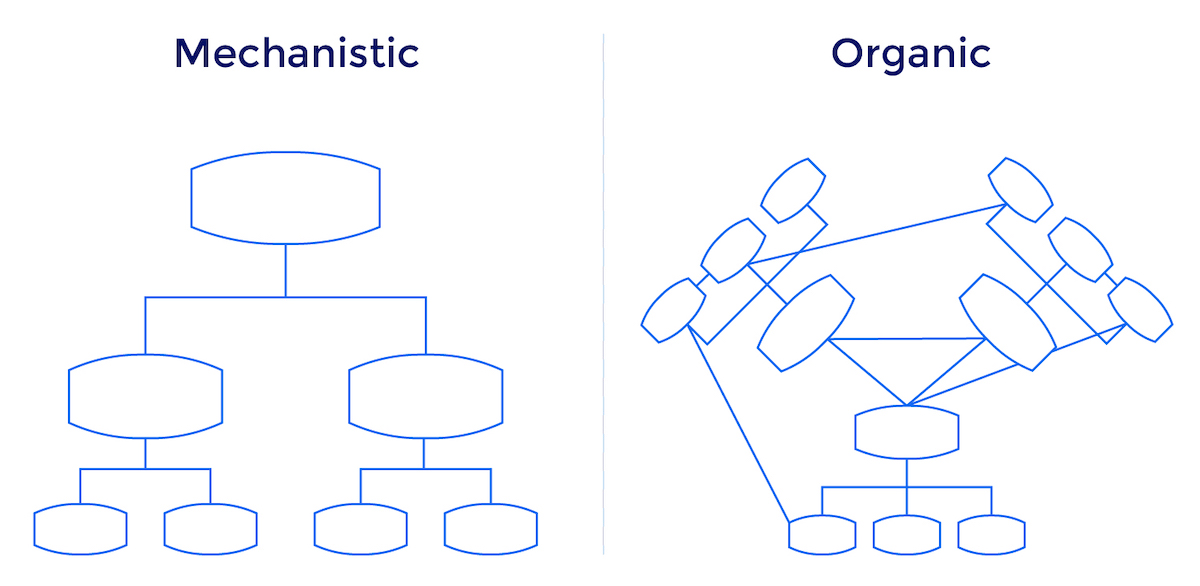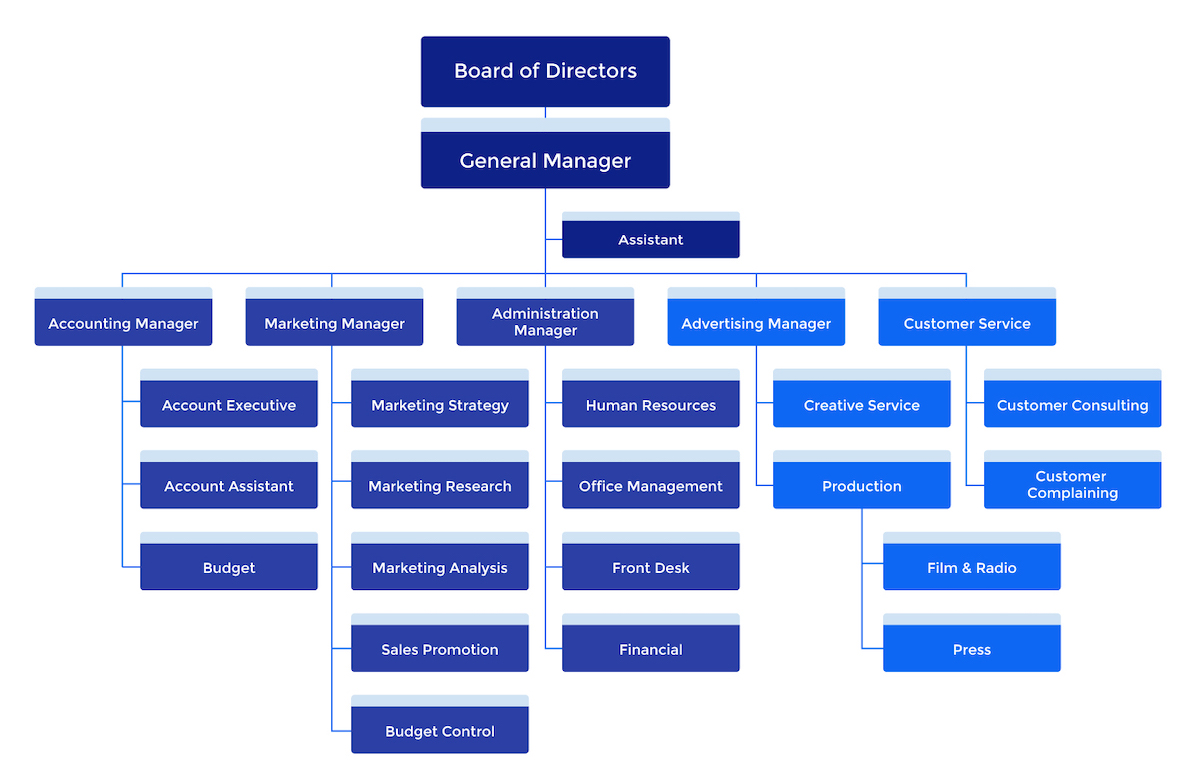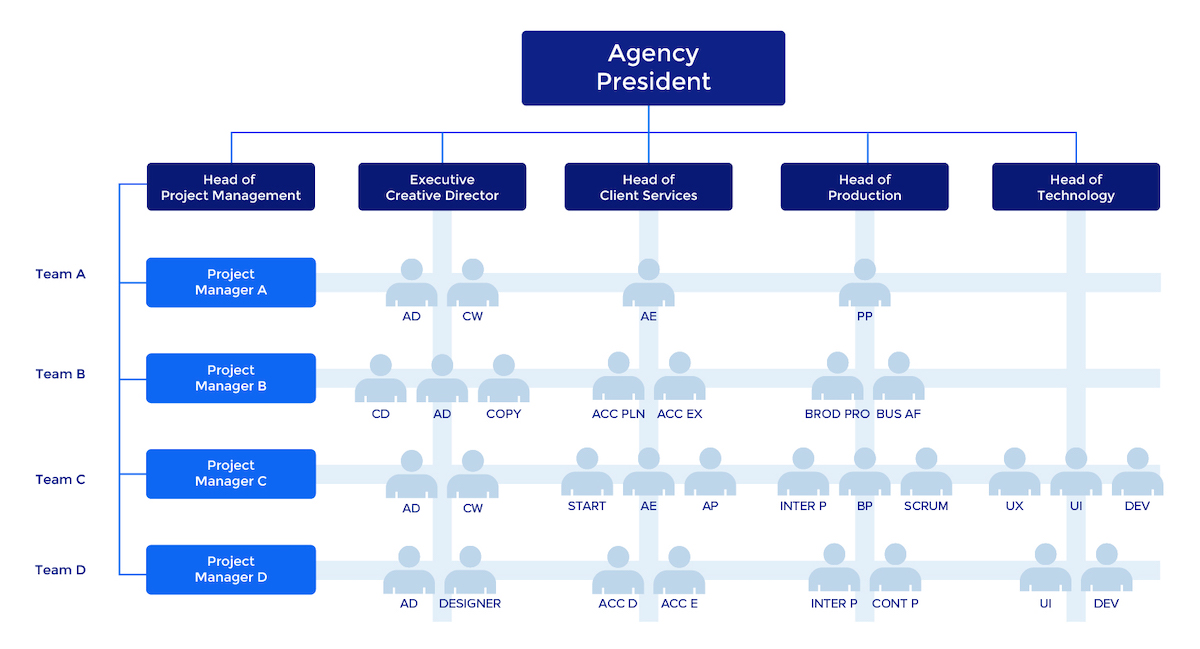Your advertising agency hierarchy is a reflection of what you aim to accomplish as a business. The inclusion of specific departments or organizational structures not only tells employees whom they should report to but should align with your strategic goals. It can also say a lot about how you collaborate with clients.
Without a well-designed hierarchy, lag times in workflow can increase and lead to unhappy clients.
Whether you’re hiring new employees for the first time or taking your team from a boutique operation to a full-service provider, this guide will outline the most common hierarchy structures and variations for your unique agency.
With the right organizational structure, your agency will operate more efficiently and be remembered by clients for the right reasons.
What is an agency hierarchy?
An agency hierarchy groups staff members according to their general responsibilities, such as within the Marketing department or a division of Customer Service. It also shows how roles are structured so that everyone knows who is their professional superior. They come in two main varieties, mechanistic and organic:

Mechanistic structures centralize power and create formal relationships between team members. Organic structures allow for cross-divisional collaboration and reduce the “gatekeeper” mentality that can surround division leads and slow process.
Both mechanistic and organizational structures have advantages and disadvantages. As you’ll see, which is best for your agency ultimately depends on your size, clients, and services offered.
The most common hierarchy organizational charts for agencies
The traditional model
The traditional model has long been the go-to structure for large advertising agencies that offer a variety of services. It tackles the issue of managing numerous employees by centralizing authority, making it clear whom everyone reports to:

The organization is broken into different divisions -- creative, production, client services, or finance. Each division is led by a department head, such as an Advertising Manager or Director of Advertising, and includes all the team members who specialize in that field.
The downsides to this structure are that it naturally silos people off and impedes cross-divisional collaboration. As a result, it’s not a great fit for agencies who offer several different services to the same client and depend upon constant communication.
Overall, this model works best when clients typically come to an agency for a specialized service that can be contained within a single department, such as SEO or brand design.
The matrix model
The matrix model keeps traditional divisions and division heads but is flexible enough to allow for the formation of cross-divisional teams:

With this model, full-service advertising agencies are able to meet all of their client’s needs without creating large barriers in communication between divisions. It tries to blend the best of both mechanistic and organic hierarchical structures.
On the other hand, this creates confusion between whom team members should report to at a given time: the project lead or the division lead.
The pod system
An even more organic approach than the matrix model is the pod system.
Leeann Leahy, CEO of The VIA Agency, developed this organizational structure for her staff. Under the pod system, traditional account managers are gone and clients have access to four project leads, including:
- Business/consumer strategy lead
- Planning lead
- Creative lead
- Project management lead
When necessary, the project leads delegate tasks to other team members within the agency.
The main objective of this model is to shorten approval process times, eliminate extraneous senior positions, increase peer accountability, and encourage what Leahy describes as “fast and furious” creativity.
Variations in hierarchy by agency type
Not every advertising agency will offer all the services that a full-service agency does. What an agency specializes in will influence what organizational structure works best for it.
SEO agencies
While a full-service advertising agency may incorporate SEO into its services, an SEO agency specializes in building a business’s online visibility with services like:
- Website analysis
- Structure optimization
- Content production
- Social media management
- Conversion rate optimization
As such, an SEO agency might only need three main divisions: strategy/project management, technical SEO, and content marketing. A traditional hierarchy model can work for an SEO agency because the services offered are usually specific and there aren’t as many divisions needed as a full-service ad agency.
Creative agencies
A creative agency usually develops and produces visual products that are used in a client’s existing marketing strategy, including:
- Art direction
- Copywriting
- Branding design
- UX design
- Web design
- Video production
These services require a lot of collaboration. For example, copywriters and ad art designers will need to work together to create a deliverable. For that reason, a matrix model might work best for a creative agency.
Variations in hierarchy by agency size
For agencies with more than one location
Agencies with more than one location give geographically diverse clients more opportunities for face-to-face interactions. It can also increase your odds of finding top talent.
Your organizational structure with different locations might look something like this:

In this model, authority is decentralized into geographic regions. This allows work to happen quickly, but if you’re not careful, lack of communication between regions can lead to confusion, such as a fragmented brand voice.
For example, if the North American and Asia-Pacific Divisions above both launched a marketing campaign to their local target audience, they should still coordinate with each other to keep the overall messaging and brand cohesive.
For large or full-service agencies
Bigger agencies offer a comprehensive list of services that can fulfill many if not all of a client’s marketing and advertising demands, whether they need help designing brand visuals or SEO specialists who can improve their organic search listings.
As such, it makes sense for large agencies to have a department dedicated to account management. Account managers serve as the liaison between the client and any team members in other departments involved in a project.
This improves the client experience by allowing them to develop a relationship with one central point of contact. The account manager is also able to deliver a cohesive message to all departments, reducing the chance for a “he said, she said” situation.
A structure like the matrix model preserves divisional authority while allowing account managers to work with a team comprised of different division members that meets all of a client’s needs.
For small agencies
Team members in small agencies typically wear many hats and have more informal, familiar relationships with their coworkers. Their roles are flexible and change on a daily, if not hourly basis.
As such, these agencies are well-positioned to experiment with a more progressive organizational structure like the pod system. Clients can have access to all members of the team without being overwhelmed, and team members don’t need to go through an unnecessary gatekeeper like an account manager to avoid causing confusion in communication.
Tips for improving the efficiency of your team’s hierarchy
You can’t rely on an organizational structure alone to keep your team running smoothly. Here are some tips for developing the right agency hierarchy for your needs, then executing it efficiently.
Establish employee buy-in
If you’re restructuring your agency’s hierarchy, seek the involvement of your managers and staff, not just your top executives or board of directors. Your employees will be the ones who operate within this new organizational structure day in and day out, and they probably have some insight into what will work best.
Be flexible at first
Bob Sanders from Sanders Consulting Group, an organization that helps agencies with their strategic goals, recommends that you approach restructuring as an evolutionary process, one that should be allowed to happen organically.
This allows you to feel out and test new structures before committing to something that doesn’t make sense for your team.
Turn senior people into coaches
Senior team members and executives have reached their status thanks to their considerable knowledge acquired over years of practice. Too often, their expertise is squandered on only approving or signing off on deliverables created by the team members they oversee.
Encouraging senior positions to also act as coaches for their team can not only increase the expertise of more junior employees, it improves the quality of the final product you deliver to clients and prevents mistakes.
Garrett Mehrguth, CEO of Directive Consulting, explains their reasoning behind using a coaching model:
When we established Directive, our management confused coaching with training. We believed our learning boards could train men and women to develop into search marketers.
We assumed people could learn to be strategic from online readings and diving right into their work. We didn’t focus on the necessity of 1-on-1 coaching. Quality control was our focus, and we neglected meaningful coaching at that time. Quality control is reactive; coaching is proactive.
Both have a place, but no training should trump coaching.
So, which advertising agency hierarchy is best?
Despite their reputation for creating silos and stifling collaboration, traditional organizational structures can still work for agencies that offer specialized services.
More organic models, however, can create exciting synergy by decreasing formality between team members. While something like the pod system might be too loose for a larger advertising agency, the matrix model shows promise by allowing flexibility while retaining clear lines of authority.
Ultimately, the best hierarchy model for your agency is the one that helps you keep employees and clients satisfied.
Developing the right hierarchy for your advertising agency is only part of the battle. Sign up for an Instapage Enterprise demo today.
